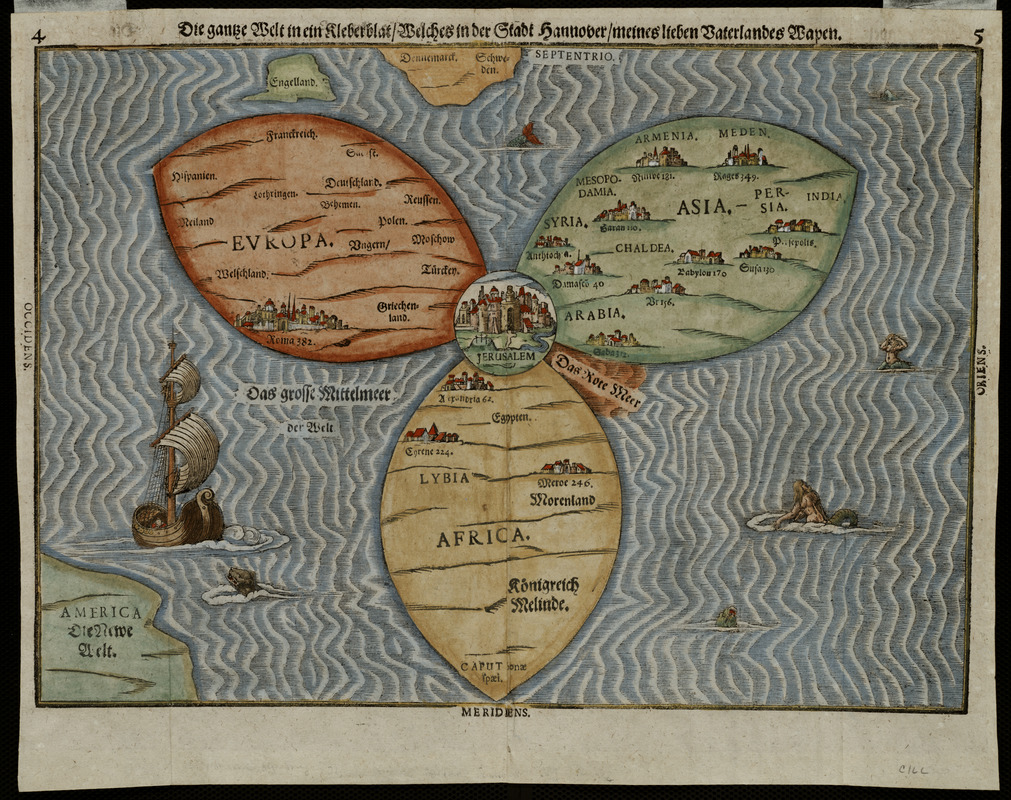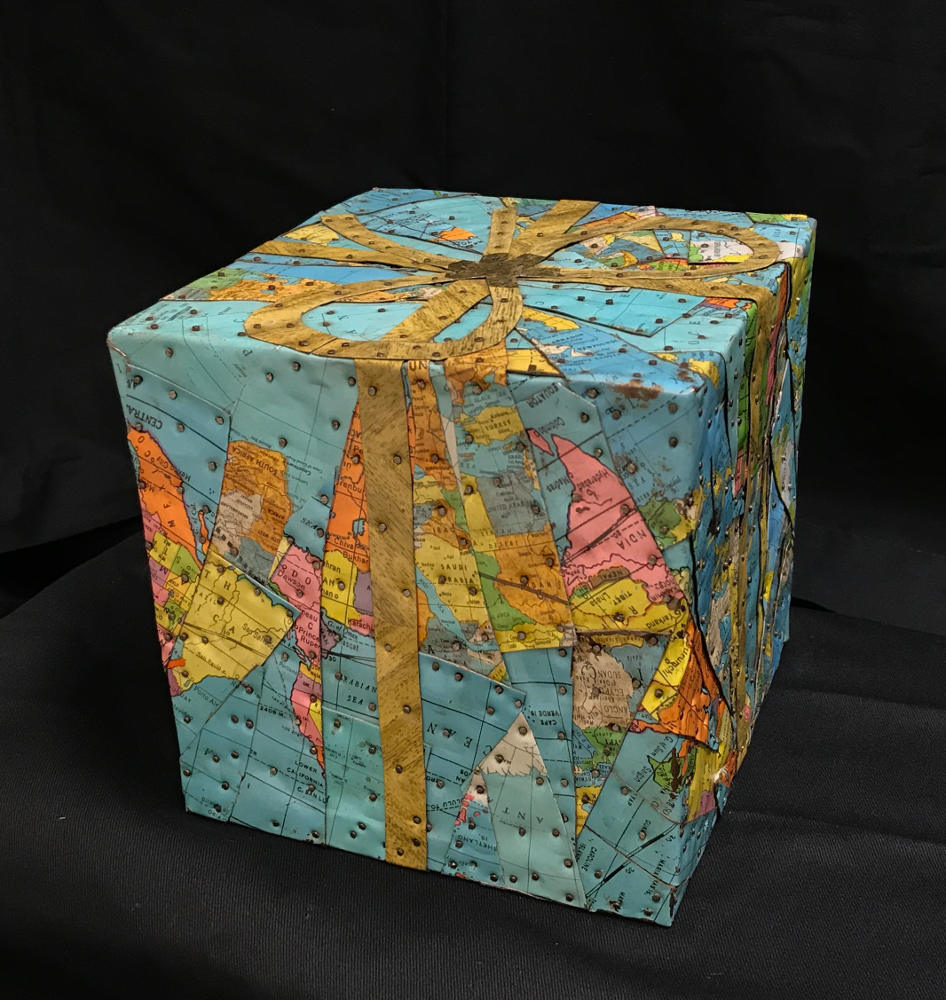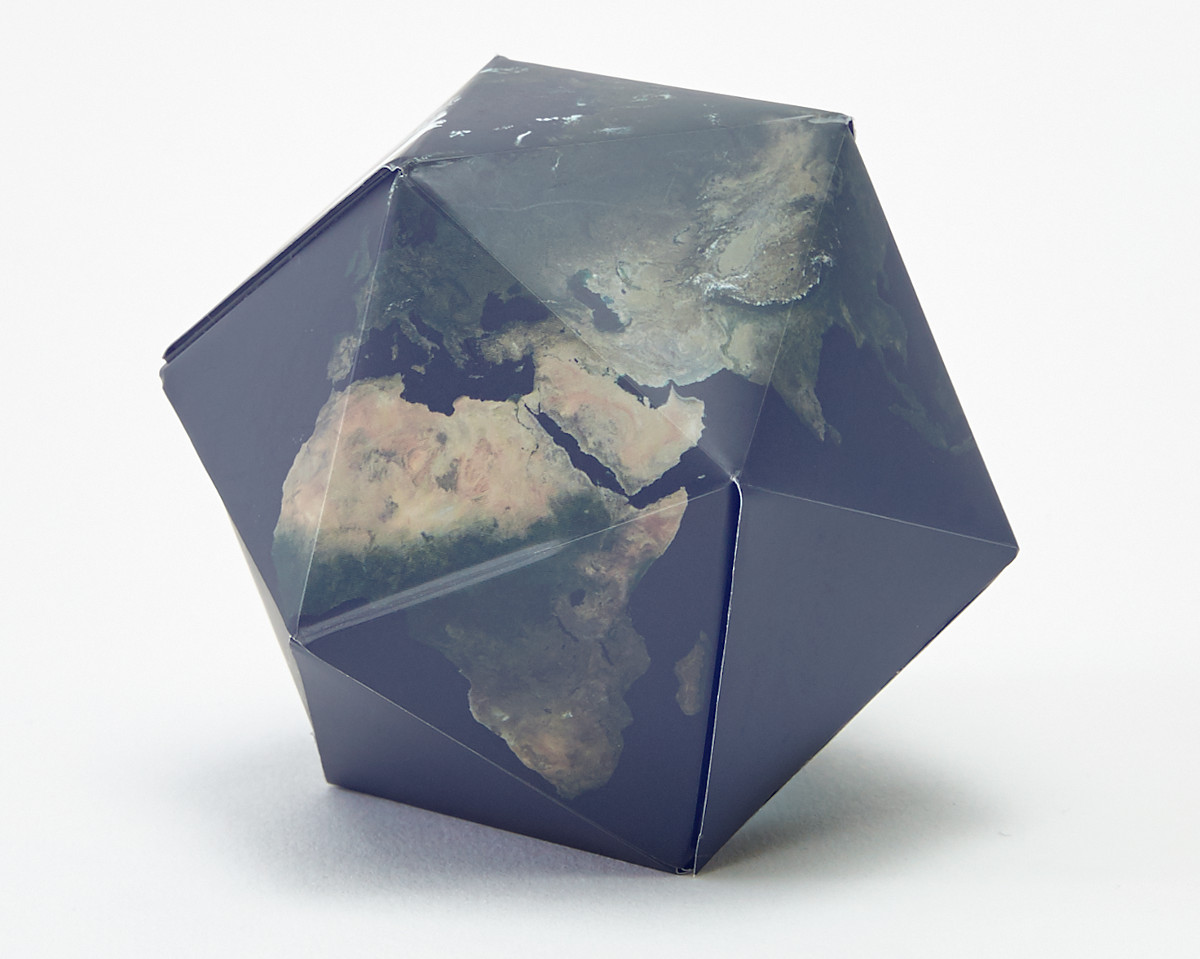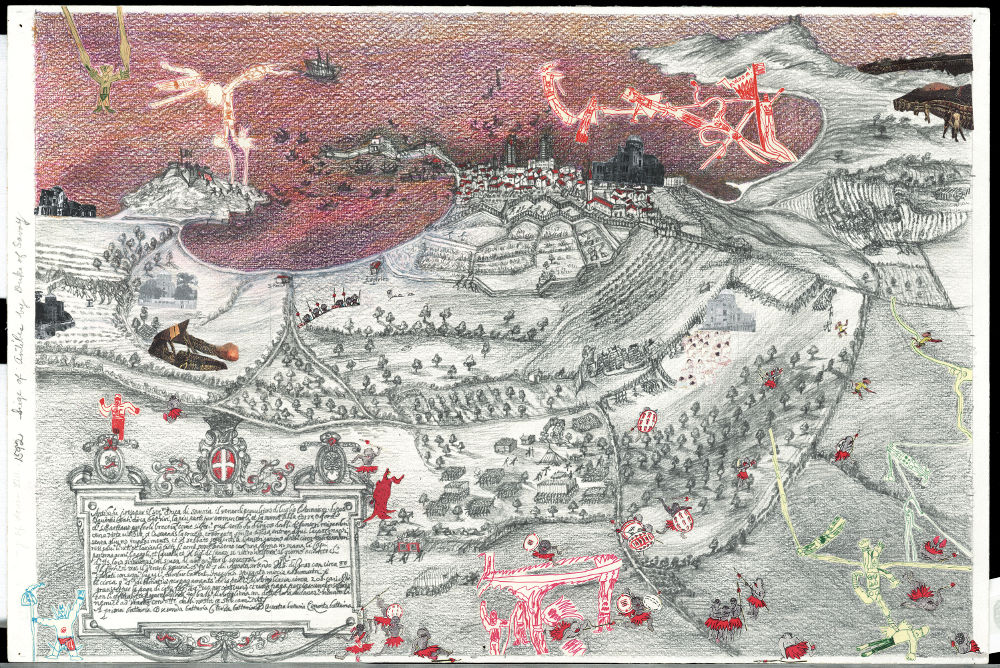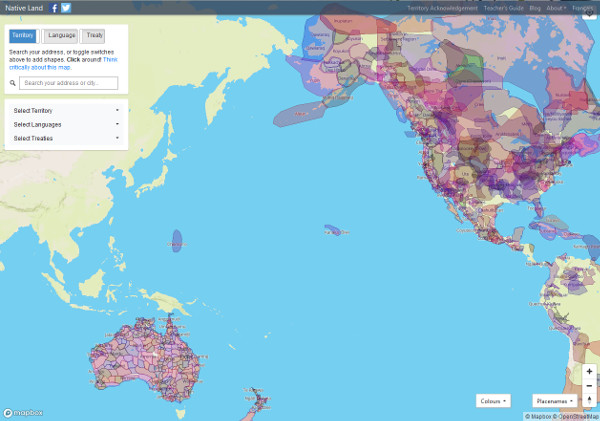Introduction
An artist’s inspiration arises from internal and external sources,
perceived and unconscious. When maps are one of those sources, artists
gain access to the power and meaning of cartographic formats and
geographic concepts. With these tools, artists chart worlds of personal
emotions, political beliefs, memories, and places beyond the geographic
documentation created by conventional mapmakers.
This exhibition juxtaposes contemporary works of art with selected maps
from the collections of the Norman B. Leventhal Map & Education
Center at the Boston Public Library. These pairings and trios create
dialogues that illuminate the crossing of the traditional boundaries of
art and maps, and stimulate a fresh appreciation of both media.
Visit the exhibition at the Leventhal Map and Education Center
1. Order Out of Chaos
Since ancient times, mapmakers have sought to make sense of humankind’s place in the world. With limited information, they attempted to understand their surroundings by mapping settlements and cultures, describing the natural world, diagramming the Earth’s place within the solar system, and developing theories and spiritual beliefs to explain their relationship to the larger universe and the heavens.
European cartographers initially identified just three continents—Asia, Africa, and Europe—centered on the Mediterranean Sea and the holy cities of the Middle East. Places were named and locations described in relative terms using measures of distance and direction. As science became a more dominant way of understanding the world, astronomers and geographers began to overlay grids resembling latitude and longitude on a spherical Earth to describe more specific and precise locations.
The maps in this section of the exhibition showcase geographic concepts developed by early cartographers to exert a sense of order on their world. These objects have been paired with works by contemporary artists who continue to grapple with similar themes.
Heidi Whitman
"Mappamundi (5)," 2018
Ink, gouache,
acrylic, paper, and cast shadows
Courtesy of
the artist; Carroll and Sons, Boston; TAG Fine Arts, London, UK
Image courtesy of the artist
Pierre Le
Rouge (- 1493)
"[Circular
World Map]" from "La Mer des Hystoires"
Paris, 1488.
Printed map, hand colored
Reproduction,
2018. Courtesy of the Rare Books Department, Boston Public Library
Medieval "mappae mundi" dating from as early as the 11th century depicted the world as a circle with three continents. This tradition inspired Heidi Whitman’s circular constructions.
Whitman reveals, “I’m interested in states of mind, how experience is translated into thought, how memories are layered, and how dreams jumble reality. Contemporary city grids and plans of ancient ruins are layered and edited along with references to mental networks.” Referring to lands yet-to-be-discovered, the artist continues, “The Terra Incognita of "mappa mundi" maps reminds me of all that is unknown about the mind.”
Pierre Le Rouge’s map reflects a 15th-century Christian representation of the world based on Biblical sources, and is oriented with east at the top. Though drawn in the tradition of "mappae mundi," this map is more than a schematic diagram, displaying kings, a pope, fantastical beasts, and over 100 place names and geographical features positioned in relatively accurate spatial relationships to one another.
Unknown
artist
"Tibetan
Mandala," 19th century
Paint on
cloth
Private
collection, Boston
“Planisphaerium Ptolemaicum siue Machina Orbium Mundi… “ from "Harmonia Macrocosmica…"
Amsterdam, 1661. Printed map, hand colored
Reproduction, 2018
The mandala, "Planisphaerium," and the quilt by Kirsten Fisher represent contrasting worlds, cultures, and media.
This 19th-century Tibetan Buddhist mandala gives us an ordered paradise of the divinities, with every detail symbolizing an aspect of the cosmos. Used as an aid for meditation, each mandala is unique, though the stylized format has remained the same for centuries.
The “Planisphaerium,” from Andreas Cellarius’ 1661 atlas of the celestial world, depicts the heavens according to the theories of 2nd-century geographer Claudius Ptolemy. Planetary gods race in chariots through a shimmering sky, while portraits of lauded astronomers adorn the margins. Their theories regarding the stars, planets, sun, moon, and zodiac are recorded throughout the atlas.
Born and raised in Copenhagen, fiber artist Kirsten Fisher reacted to the turmoil of everyday life in her new home, New York City, by creating this explosive image of the urban freneticism of the metropolis. Her use of bold colors and alternating geometric and undulating shapes project a propulsive energy.
Like the celestial map by Andreas Cellarius and the Tibetan Buddhist mandala, this contemporary artwork assigns circular outlines—albeit nebulous ones—to a chaotic world. Fisher writes, “You can feel trapped by all the chaos and changes that are going on around you, but sometimes there is beauty in chaos.”
A faintly drawn grid suggesting longitude and latitude overlays Daniel McDonald’s evocation of continents and seas. McDonald uses grids as a way to “balance order and chaos” in his abstract paintings. A joyful use of color is typical in his work; here, the blue background conjures oceans while abstract forms imply islands and continents.
In contrast, Matthew Fontaine Maury’s 19th-century chart employs a grid to plot whale locations for commercial whaling fleets. Maury prepared the map while at the U.S. Naval Observatory, using information from ships’ logs documenting currents and temperatures in particular locations with corresponding whale activity. He is recognized as the father of the science of oceanography, especially because of his role in creating a series of wind and current charts for oceans worldwide.
2. Projections & Distortions
A map can be defined as a selective, graphic representation of a geographic space. All maps show some degree of distortion and bias, and it is important to understand the choices a cartographer has made in creating a map.
The only true representation of the Earth’s surface is a sphere, so no two-dimensional image on a flat surface can accurately preserve all four geographic qualities: shape, size, direction, and distance. No matter what projection is chosen, one or more of the essential geographic qualities will be distorted, and mapmakers display their biases by selecting a particular projection. Additionally, they show bias in their selection of a center point of focus, or an orientation—such as the standard North at the top of the map.
In this section, artists manipulate projections and play with geographic distortion. They also subvert geographic reality by creating imaginary landscapes, just as cartographers often inserted geographic myths into their interpretations.
Heinrich Bünting (1545-1606)
“Die gantze Welt in ein Kleberblat …” from "Itinerarium Sacrae Scriptura …"
Magdeburg, 1581. Printed map, hand colored
Courtesy of the Mapping Boston Foundation
Alexander Gorlizki
"If You Could Just Reconsider," 2011
Pigment and gold on paper
Private collection, Boston
Myth and imagination are conjured in the three works here. Alexander Gorlizki’s opulent painting suggests a fantastical land populated by a combination of contemporary artifacts with figures from India’s past, painted at Gorlizki’s direction by classically trained miniaturist Riyaz Uddin. Elegantly and meticulously rendered, the image blurs the distinction between old and new worlds, real and imagined.
The diagrammatic 1581 cloverleaf map, conceived by Heinrich Bünting, emphasizes the mapmaker’s Christian focus. Jerusalem is placed at the center surrounded by three continents in a sea populated by fantastical beasts and bordered by other geographical locations, such as America.
The 1525 Ptolemaic map by Lorenz Fries also presents a world view based on knowledge, religion, and myth of the time.
Lorenz Fries (ca. 1490-ca.1531)
“Tabula moderna Indiae” in Claudius Ptolemy’s "Geographia"
Strasbourg, 1525. Printed map
Cataloging, conservation, and digitization made possible in part by The National Endowment for the Humanities: Exploring the Human Endeavor.
This map hails from a 1525 edition of Claudius Ptolemy’s "Geographia", a text originally written in the 2nd century. Along with the works of Gorlizki and Bünting, this atlas allows the viewer to spatially orient religious beliefs and mythologies; illustrations throughout the book depict legends and belief systems across the world. Showing part of India, this particular map features a pictorial rendering of the "Daksha yajna," an important event in Hindu scripture in which Daksha, a son of Brahma, held a "yajna," or sacrifice. Following a series of arguments, Daksha’s daughter, Sati, meditated to the point of self-immolation. Grief-stricken, her husband, the god Shiva, beheaded Daksh/a and replaced his head with that of a goat. Shiva then wandered the universe with Sati’s body, scattering her ashes in holy places. These became the Shakti Peetha, sacred places throughout modern-day India, Nepal, Bangladesh, Tibet, Sri Lanka, and Pakistan.
Tony Berlant
"Christopher Who?," 1968
Metal collage on wood
Private collection, New York
Designed by Brendan Ravenhill with the
Buckminster Fuller Institute for Areaware
"Dymaxion Folding Globe - Satellite Earth," 2016
Synthetic paper and magnets
No Image Available
Buckminster Fuller (1895-1983) and Shoji Sadao (b. 1927)
"Dymaxion Airocean World: The Raleigh Edition of Fuller Projection"
Raleigh, North Carolina, 1954. Printed map
Reproduction, 1982
Tony Berlant presents the Earth viewed as a skewed joke: a pop artist’s planet made from a painted tin globe, which has been reconfigured into a whimsical form. His work is made of signs and artifacts that he has collected over the years and nailed together in unexpected shapes and combinations. He says, “The things that are in your head that come out when you are making art…don’t always have an obvious source.”
In contrast to Berlant’s sculpture, Buckminster Fuller’s “Dymaxion” globe offers an unconventional yet scientific view of the Earth in three dimensions. An inventor, architect, and global systems visionary, Fuller created the "Dymaxion Airocean World" map in 1954 with co-cartographer Shoji Sadao. This projection presents the Earth’s landmasses as a single island, floating in the ocean, without any obvious distortion of the relative shapes or sizes of the land areas. The projection folds into an icosahedron, or 20-sided polyhedron, offering one solution for the mapmaker’s dilemma encountered when depicting a round Earth on a flat map.
Martin Behaim (1459-1507)
[Facsimile of Martin Behaim’s 1492 "Erdapfel"]
Leipzig, 1992.
Courtesy of the Mapping Boston Foundation
Unlike Berlant's sculpture and the Dymaxion globes, this one is more conventional. On the eve of Christopher Columbus’ first voyage across the Atlantic Ocean, Martin Behaim of Nuremberg constructed a globe, or spherical model of the Earth, that he called an “Erdapfel” (“Earth apple”). It is the oldest surviving example of a terrestrial globe. The Americas are notably absent in this globe; instead it was believed that a Eurasian landmass extended over 65% of the Earth’s surface, rather than one third (as we now know). As a result, Columbus famously and erroneously believed that he could reach the east coast of Asia by sailing west from Europe across the Atlantic.
Abelardo Morell
"Map in Sink," 1996
Gelatin silver print
Courtesy of the artist and Edwynn Houk Gallery
Vincenzo Coronelli (1650-1718)
“Citta di Venezia” from "Atlante Veneto"
Venice, 1693. Printed map
Reproduction, 2018
Cataloging, conservation, and digitization made possible in part by The National Endowment for the Humanities: Exploring the Human Endeavor.
These two works—one a 17th-century bird’s-eye view of Venice, the other of a city perched above its harbor, crumpled and stuffed into a sink—offer unexpected and disorienting presentations of otherwise conventional maps.
Abelardo Morell disrupts the boundaries of what we expect to see in the everyday world by presenting ordinary objects from absurd or unfamiliar vantage points. This photograph defies our expectations of what belongs where, and how an object is supposed to look. In presenting the viewer with a map, rumpled and startlingly placed in a sink, Morell disrupts the authority and physical expectations that we assign to maps.
Offering another unusual perspective, Vincenzo Coronelli presents a bird’s-eye view of Venice giftwrapped in a trompe l’oeil ribbon, blurring the lines between map and reality. Intertwined with vines and including an illustration of the symbolic lion of Venice, this ribbon is emblazoned with the arms of cities and comunes within the Republic of Venice. Whereas Morell plays with perspective to subvert the authority of maps, Coronelli uses a similar device to reinforce the power of his subject.
Carly Glovinski
"#lakewinnie," 2013
Ink and acrylic on folded aluminum flashing
Private collection, New York
Image: Michael Winters
George Snow (1826/7-1885)
"Map of the White Mountains, N.H."
Boston, 1872. Raised relief model, papier-mâché
These two works employ unexpected three-dimensional qualities. Carly Glovinski uses painted aluminum flashing that is bent to look like a carelessly folded paper map. She describes the piece as “an homage to the craft of mapmaking” in the age of GPS. It is also an unconventional alternative to traditional landscape painting, not unlike a bird’s-eye view, asking us to consider: What is art? What is a map?
George Snow’s relief map of the White Mountains, with Lake Winnipesaukee appearing at the bottom, was produced as a visual aid for schoolchildren. Instead of drawing contour lines over the mountains to show their relative heights, papier-mâché is used to build up the surface to reflect topography.
3. Coastlines & Waterways
From the late 17th through the early 20th centuries, nautical charts became an important cartographic genre as European powers explored Africa, Asia, and the Americas. As explorers approached lands previously unmapped by Europeans, they charted the coastlines and major rivers that often paved the way for creating wide-ranging colonial empires.
As European sea powers expanded their reach, mapmakers continued to produce increasingly detailed and accurate charts and realistic landscape views of coastlines, harbors, and rivers to guide ships in safe passage.
In the accompanying works of art, hydrographic features have provided inspiration for contemporary artists.
Bruce Myren
"N 40° 01’ 11.38” W 124° 02’ 48.59” Shelter Cove, California," 2012
Photograph on aluminum
Courtesy of the artist and Gallery Kayafas, Boston
Joseph F. W. Des Barres (1721-1824)
“Appearance of the land from the White Islands to St. Mary’s River…” from "The Atlantic Neptune"
London, 1781. Printed map, hand colored
Two coastal views from opposite sides of North America document specific locations. Bruce Myren produced a series of photographs along the 40th parallel of latitude bisecting the United States. These personal views provide a visual commentary on the abstract mapping system of longitude and latitude, described by the artist as “our human desire to create systems and locate ourselves within them.” The work displayed here represents the terminus of the series as the viewer on land gazes out to the Pacific Ocean.
The headland views of Nova Scotia portrayed by British chart maker Joseph F. W. Des Barres predate Myren’s works by some 240 years. While artfully rendered, they were intended to function as visual guideposts for navigators, depicting the view seen from a ship as it approaches the shoreline from the Atlantic. As additions to nautical atlases, these illustrations were an essential tool for mariners navigating unfamiliar coastal waters.
Mary Armstrong
"Points of View," 2007
Mixed media on paper
Courtesy of the artist
William Bowen (1836-1893)
"Lloyd’s Map of the Lower Mississippi…"
New York, 1862. Printed map, hand colored
Venice and New Orleans are both cities renowned for beauty and pleasure, but threatened by climate change.
Mary Armstrong’s concern about how humans are altering our relationship to the Earth influences her work. After a residency in Venice, she said: “I began to sense there was an idea…a visual vehicle to carry all the color and texture of what I was experiencing. When I found a book on the Venetian Lagoon that was full of beautiful 15th-century maps, I knew I had found the perfect companion for my visual thoughts.”
Shown on this map as a dense block of squares between Lake Ponchartrain and the Mississippi River, New Orleans was the center of trade from plantations that are visible as long lots bordering the river to the north. Canals and ditches were developed in an attempt to mitigate flooding, even in the 19th century. Today, as a result of severe storms and rising sea levels, Louisiana’s wetlands are disappearing faster than any on the planet.
Naoe Suzuki
"Water, is Taught by Thirst (BLUE), Greater Boston," 2015
Mineral pigment, watercolor, walnut ink, and tea on paper
Courtesy of the artist
Boston (Mass.) Engineering Dept.
"Map of Charles River Showing Principal Sources of Pollution"
Boston, 1892. Blueprint
Reproduction, 2018
“Water, is Taught By Thirst,” a quote from an Emily Dickinson poem, is the title of Naoe Suzuki’s series, motivated by her concern for water resources. This work traces waterways from a topographical map of Greater Boston, with the Charles River basin and Boston Harbor at the top. Suzuki selected these materials, textures, and colors to evoke both homage and need. “Water is not like any other resource,” she says. “It’s not something we can choose to live without.”
The paired 1892 blueprint map by the Boston Engineering Department, while sharing some of the delicate aesthetic of Suzuki’s artwork, takes an analytical approach, pinpointing sources of pollution of the Charles River and grading them from “Serious” to “Abominable Nuisance.” Today, a concerted cleanup effort has led to a rating by the Environmental Protection Agency of “A-minus,” and plans for a swimming venue on the Charles are underway.
4. Urban Life
Human habitation, resource exploitation, and industrialization have greatly altered our physical landscape, producing distinctive settlement patterns around the world. Mapmakers have long been fascinated with plotting and delineating these human-made features. Within the hierarchy of farms, villages, towns, and cities, the latter have received major attention by mapmakers. Their work employs a variety of perspectives, ranging from traditional street maps to oblique or bird’s-eye views to horizontal or landscape views.
Inspired by the geometry, density, color, and perspectives of urban mapping, the artworks in this section capture the essence of urban vitality, structure, and architecture.
Today, Jamaica Plain is a Boston neighborhood dense with triple-deckers, leafy streets, and Victorian houses, hosting a community with a diverse populace.
Richard Youngstrom recreates and celebrates his hometown using the picassiette (broken ceramics) style of contemporary mosaics. Grout lines indicate streets, a shimmering form in the upper center represents Jamaica Pond, and an upper-right-to-lower-left diagonal designates the Orange Line subway.
During the early 19th century, Jamaica Plain was known as a summer resort for wealthy Bostonians. The town evolved into a streetcar suburb and industrial community in its own right. Towards the end of the century, bird’s-eye views such as this one were created to promote and celebrate the development of towns and communities. In this aerial view looking northwest, Jamaica Pond and Brookline are on the horizon, and illustrations of civic and residential buildings in the margins advertise the appeal of the community.
Abby Goldstein
"Untitled," 2013
Watercolor and pencil on handmade paper
Private collection, Boston
Abby Goldstein states, “Maps encompass a universal language that crosses cultures. I am fascinated by how information is reduced into basic shapes and color that reveal the stories of habitation, landscape, occupation, and industry. I set about inventing a navigational system inspired by my environment and responding to what I see, hear and feel. What emerges is a constructed fictional map based on symbols of disruption and transformation.”
Created by Ilonka Karasz in 1927, this playfully illustrated tourist guide to Paris highlights the delights found on the city’s labyrinthine streets. As a designer and illustrator, Karasz was among the first women to attend the influential Vienna Workshop, and was subsequently granted opportunities generally reserved for men. She created several maps and designed in wide variety of other media, including 186 "New Yorker" magazine covers spanning 30 years.
5. Borders & Conflicts
Since the inception of printed maps in the 15th and 16th centuries, a primary component of general reference cartography in atlases and school geographies has been the depiction of boundaries of individual provinces, states, and countries. As empires have expanded and contracted, historical and pictorial maps have been used as instruments of politically-motivated propaganda, while maps and atlases of individual countries are often expressions of national identity.
As political conflicts resulting from border disputes are constantly addressed by our current news media, artworks in this section deploy cartographic elements to comment on conflicts and acts of injustice.
Joyce Kozloff
"Boys’ Art #24: Siege of Antibes, 1592," 2001-2002
Mixed media on paper
Courtesy of DC Moore Gallery, New York
Image courtesy of the artist and DC Moore Gallery, New York
In Joyce Kozloff’s "Boys’ Art" series, renditions of her son’s drawings of superheroes and warrior figures are affixed to historical battle sites, a commentary on the omnipresence of war in our daily lives. The inclusion of images from "Babar the Elephant" storybooks and of the Hiroshima Peace Memorial create a jarring and provocative combination. “I luxuriate in the sheer beauty of maps, as incised diagram and reflection of our world,” she notes. “Coexisting social concerns have been with me from my beginnings as a young feminist artist: how to create an art that is both graphically satisfying and intellectually questioning.”
During the Civil War, daily newspapers used maps to inform their readers about the changing fortunes of an ensuing battle. Representing a Confederate viewpoint, this battle map features the strategic placement of troops, geographic topography, the position of enemy Yankee artillery, principal buildings, roads, and drainage. Viewed alongside Kozloff’s work, this map anchors her contemporary, fantastical battle view in the grim history of war on American soil.
Abel Barroso
"La Mesa de las Negociaciones," 2012
Collage on paper
Private collection, Boston
William R. Shepherd (1871-1934)
“The Partition of Africa,” from "Historical Atlas"
New York, 1911. Printed map
Reproduction, 2018
Geographical Publishing Co.
"Spherical Projection World"
Vancouver, [1913]. Printed map
Reproduction, 2018
Borders, political dominance, and colonial rule: these were headline news one hundred years ago just as they are today.
Abel Barroso’s title, "La Mesa de Las Negociaciones," translates to “The Table of Negotiations.” In this piece, he explores borders as structures of power. “I want to point out the marks or imaginary lines that cannot be crossed, whether they are borders between countries or between people,” he says. “I want to provoke a global interpretation and reception using my visual language, the language I have as an artist.”
Blatantly imperialistic, these two maps were made during the political tensions before World War I to declare world powers’ land claims. In “The Partition of Africa,” European leaders divvied up the continent for their nations’ economic gains. In the "Spherical Projection World" map, global dominance is asserted with the images of international leaders and their flags. Explorers and commentary on polar discovery are also included, indicating there were new territories yet to be conquered.
No Image Available
Jonathan Callan
"South West America: Buried Names & Absent Names," 1998
Pierced maps (diptych)
Private collection, New York
Alexander von Humboldt (1769-1859)
"Carte du Mexique et des pays limitrophes situés au nord et á l’est …"
Paris, 1811. Printed map
"Native Land"
Native-Land.ca.,
2015
English artist Jonathan Callan maps the ancestral lands of indigenous peoples in the American Southwest. Through erasures and holes punched in the paper, he evokes the forced removal and genocide of Native people. He asserts, “I wanted the place names forced below the surface. As if names could be put in the ground.” Although the title of this diptych suggests a particular geography, the work acts as a metaphor for all appropriated Native lands.
Baron Alexander von Humboldt was a German geographer who visited the region in 1803 and researched unpublished cartographic resources and documents in the Mexican archives. The resulting map provided Europeans and Americans with the most comprehensive printed geography of Mexico to date, recognizing the names and lands of Native Americans living on the country’s northern frontier (today’s southwestern United States).
The "Native Land" digital interactive is a contemporary mapping of the names and lands of Native American peoples.
Tiffany Chung
"Berlin Wall," 2010
Embroidery, metal grommets, and buttons on canvas
Private collection, Boston
Photograph courtesy of the artist and Tyler Rollins Fine Art, New York
Political boundaries and power struggles define these two works.
Delicate watercolor combined with embroidery entice the viewer to look closely at Tiffany Chung’s work, only to discover that it deals with our world’s most traumatic conflicts. In the artist’s words, “My cartographic drawings and installation works, as a whole, examine issues of conflict, migration, urban progress and transformation in relation to history and cultural memory. I continue to struggle and fumble in figuring out what we can do when confronted by injustice and pain in a world in which only a small group of people holds the power and makes decisions for all of us.”
The 19th-century “serio-comic map” caricaturizes each European country as a fisherman, holding a sack with its imperial catch, or about to lose what it has caught. Serving as an allegory for European colonial interference elsewhere, this type of “persuasive” map influenced and reflected popular opinion, much like a political cartoon.
Bibliography
"Alexander Gorlizki." Berggruen. http://www.berggruen.com/artists/alexander-gorlizki.
Bambach, Carmen C. Michelangelo: Divine Draftsman and Designer. Metropolitan Museum of Art, 2017.
Brotton, Jerry. A History of the World in 12 Maps. Viking, 2013. [G1030 .B7 2013x]
Brown, Jeremy. "Putting Myth on the Map: Imaginary Landscapes in Early Modern Calabria." Presented at the Symposium of the International Society for the History of the Map, Portland, ME, 2018.
Charles River Conservancy. River Stories: Volume III: A Treasury of Poems, Stories, Artwork, Maps about the River and its Parklands by Those Who Cherish Them. Charles River Conservancy, 2015. http://www.thecharles.org/media/uploads/2013/04/RSIII-Hi-Res_reduced.compressed.pdf.
Cornell University. Persuasive Cartography: The PJ Mode Collection. https://persuasivemaps.library.cornell.edu/.
Cotter, Holland. “Tiffany Chung.” The New York Times, September 29, 2017. https://www.nytimes.com/2017/09/28/arts/what-to-see-in-new-york-art-galleries-this-week.html.
Chung, Tiffany. "Presentation by Tiffany Chung." Presented at Asia Art Archive in America, New York, NY, November 7, 2010.
Gefter, Philip. “Google Earth is His Muse”. The New York Times, August 30, 2015.
Grim, Ronald E. and Debra Block. Torn in Two: 150th Anniversary of the Civil War. The Norman B. Leventhal Map Center, 2011. [E468 .B735 2011x]
Grim, Ronald E. and Roni Pick. Journeys of the Imagination. Boston Public Library, 2006.
Grim, Ronald E., Roni Pick and Eileen Warburton. Boston & Beyond: A Bird’s Eye View of New England. Norman B. Leventhal Map Center at the Boston Public Library, 2008. [GA190 .G74 2008x]
Harmon, Katherine A. The Map as Art: Contemporary Artists Explore Cartography. Princeton Architectural Press, 2009. [N8222 .M375H37 2009]
Hessler, John. Map: Exploring the World. Phaidon, 2015. [GA105.3 .M384 2015]
Kozloff, Joyce. Boys’ Art. Distributed Art Publishers, 2003.
Krieger, Alex, and David A. Cobb, editors. Mapping Boston. MIT Press, 2001. [GA430 .M36 2001x]
McQuaid, Cate. “Cities of the Mind: Maps and Vistas Both Physical and Metaphysical”. The Boston Globe, September 16, 2015.
Miller, Naomi. Mapping Cities. University of Washington Press, 2000. [RARE BKS GA190 .M55 2000 FOLIO]
Nurminen, Marjo T. The Mapmakers’ World: A Cultural History of the European World Map. John Nurminen Foundation, Pool of London Press, 2015.
Pal, Pratapaditya. Tibetan Paintings: A Study of Tibetan Thankas, Eleventh to Nineteenth Centuries. Sotheby Publications, 1984. [FINE ARTS ND1432.C584 P3 1984]
Peraza, Maeva. "In Conversation: Abel Barroso." Cuban Art News, October 7, 2014. https://www.cubanartnews.org/2014/10/07/in-conversation-abel-barroso/4030/.
Pollack, Barbara. "Joyce Kozloff Revisits Her Childhood Drawings and Maps to Address Present-Day Anxieties." Hyperallergic, October 12, 2017. https://hyperallergic.com/405310/joyce-kozloff-revisits-her-childhood-drawings-and-maps-to-address-present-day-anxieties.
Schwartz, John and Mark Schleifstein. "New Orleans, Fortified but Still in Peril." New York Times, February 25, 2018.
Solnit, Rebecca, and Rebecca Snedaker. Unfathomable City: A New Orleans Atlas. University of California Press, 2013. [G1364.N5 S6 2013]
Suzuki, Naoe. Be Water, My Friend. Self-Published, 2015.
Thrower, Norman Joseph William. Maps & Civilization: Cartography in Culture and Society. 3rd ed. University of Chicago Press, 2008. [GA201 .T47 2008]
Tsai, Sylvia. "Tiffany Chung: To Be Remembered." ArtAsiaPacific 100 (Sep/Oct 2016): 128-137.
Wilford, John Noble. The Mapmakers. Knopf, 1981. [GA105.3 .W49 1981]
Woodward, David, ed. Art and Cartography: Six Historical Essays. The University of Chicago Press, 1987. [GA108 .A78 1987]
Art Exhibitions
Armstrong, Mary. Memory of Desire: Mapping the Venetian Lagoon. Victoria Munroe Gallery, Boston, MA ,2007-2008.
Chung, Tiffany. The Unwanted Population. Tyler Rollins Fine Art, New York, NY, 2017
Harmon, Katherine. You Are Here NYC: Art, Information and Mapping. Pratt Manhattan Gallery, New York, NY, 2017.
Islands. Williams Collection, Wellesley, MA, 2017.
Kozloff, Joyce. Girlhood. DC Moore Gallery, New York, NY, 2017. http://www.dcmooregallery.com/exhibitions/joyce-kozloff-girlhood.
Mapping Brooklyn. BRIC House and Brooklyn Historical Society, Brooklyn, NY, 2015.
Manolson, Ilana. Personal Terrain: Contemporary Mapping. Concord Art Association, Concord, MA, 2014.
Sáenz-López Pérez, Sandra. Marginalia in Cartography. Chazen Museum of Art, Madison, WI, 2014.
Credits
Curator
Janet Spitz
Norman B. Leventhal Map & Education Center Staff
Connie Chin, President
Lynn Brown, Education Coordinator
Lauren Chen, Reference and Cataloging Librarian
Alison Cody, Development Manager
Ronald Grim, Consulting Curator of Maps
Lauren Kennedy, Communications and Administrative Lead
Dory Klein, Map Librarian
Michelle LeBlanc, Director of Education
Belle Lipton, GIS Map Librarian
Education materials created by:
Michelle LeBlanc, Director of Education
Lynn Brown, Education Coordinator
Framing and Matting
Andrew Leonard
Consulting Registrar and Exhibition Manager
Rebecca Lowell
Boston Public Library Staff
David Leonard, President
Communications Department
Digital Services
Facilities Department
IT Department
Rare Books Department
Research Services
Graphic Design and Production
Advanced Imaging
Neva Corbo-Hudak Graphic Design
The Market King
Lenders
Private collections in Boston and New York
Mary Armstrong
DC Moore Gallery, New York
Kirsten Fisher
Mapping Boston Foundation
Abelardo Morell
Bruce Myren
Naoe Suzuki
Heidi Whitman
Richard Youngstrom
Special Thanks
Judith Hoos Fox, Independent Curator, c2-curatorsquared
Karen Haas, Lane Curator of Photography, Museum of Fine Arts, Boston
Jeremy Pool
Jon Truslow, Photography
Stephen Truslow
Press
Museum Open House "Crossing Boundaries: Art // Maps"
NewTV, November 19, 2018
At the BPL, the Art of Getting from Here to There
The Boston Globe, October 18, 2018








